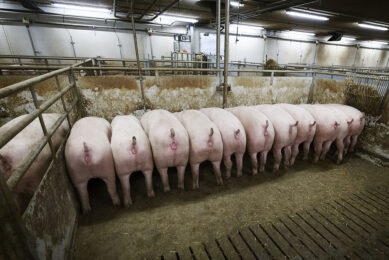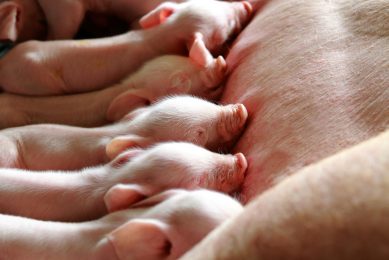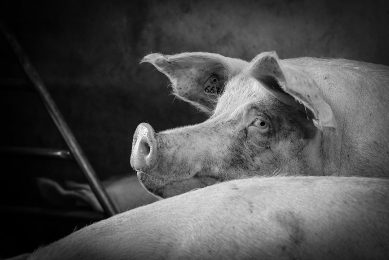Thinking ahead: Essential for sow management

About 15% of all farms are run by real experts doing well despite some difficult times. The ability to ‘think ahead’ in several management areas is one reason why these leaders are succeeding. What do these areas encompass?
By John Gadd
Thanks to prodigious genetic advances since 1998 – when whispers of ’30 pigs per sow per year’ began to appear – the gilt is a very different animal now compared to the 1998 model. Modern day productivity of 12 to 16 born-alives in her first litter and the promise of this being repeated in the second and third ones are becoming more and more likely. If I turn to the records I have secured from the leading experts concerning ‘Weaning Capacity’, my 15% top clients achieved over 500 kg weaner weight per sow lifetime (which is what ‘weaning capacity’ describes) compared to the 320 kg – and often much less – of the other 85%, a big difference.
Much of it must be due to their ability to think ahead, not only where any gilt is concerned but especially with these increasingly common ‘hyperprolifics’. Because of their phenomenally large first litters, exhaustion and consequent slow re-breeding recovery causes a poor second and third litter performance. Here are some figures from my file to illustrate how thinking ahead helps to manage hyperprolificy. The 15% averaged 70 pigs per sow over a lifetime of 4.2 parities, while the rest managed 46, perhaps 50 in some cases. In total, 81% of their herds never averaged 3.5 parities, with as many as 21% of sows being culled due to low numbers born after only parity 2.
A thinking ahead plan for gilts
Figure 1 is my attempt to show that the thinking ahead process starts as early as 70 kg. It outlines the critical feeding and management actions needed to give the hyprerprolific gilt a firm start to her productive life and maintain her genetic capability subsequently.
Note: The new diets – gilt developer and gilt lactator. Different nutrient specifications to the grower 1 and sow lactation diets still being used for gilts. There is no need to alter the existing, well-established and perfectly satisfactory daily feed allowances, and the new specs provide revised daily nutrient intakes for the hyperprolific gilt, given normal climatic conditions. If in doubt, consult the nutrition advisor of your breeding stock supplier as appetites can vary between the lines.
Note too… The steady and unhurried build-up to that first big litter to allow this high-performance animal to develop physically as well as physiologically, and, not often mentioned, to acquire a strong immune shield against what I call ‘productivity-stress’. The protocols and strategy recommended by specialists in gilt preparation and management such as Prof Hughes in Australia and Dr Foxcroft in Canada are just as effective with the new genetics as with the older ones.
And… The growing importance of the gilt pool which itself gives the facility and time to plan gilt replacements well ahead, and devote enough care to this most important animal in the herd – the gilt.
Attended farrowing
For decades I have promoted the importance of ‘being nearby at farrowing’. In the days of smaller units it was not feasible to have a night-shift, so the welcome arrival of injectable methods of encouraging/ ensuring the sows farrowed only during (slightly-extended) working hours was a welcome innovation. It had its teething troubles and needed careful discipline which producers were not always willing to provide, but when experience was gained it works well – even better in my experience than the makers claim.
Many clients, after a year’s diligence were saving at least pig a litter. In addition and not often mentioned, enforced culling was lower so that the gilts and sows who enjoyed attended farrowing went on to provide a nearly a whole parity more by the end of their productive lives. This alone raised weaning capacity by 107 kg – quite a substantial amount of extra weaner weight, overriding the cost by a factor of four and reducing the need for replacement working capital by more than a fifth.
But why the extra 0.91 of a parity obtained before routine culling? With the stockperson present at farrowing to oversee how things were going, the gilts and sows, especially today’s prolific ones, had some of the strain lifted from them by the stockperson having the time use fostering, piglet swapping and devices like a rescue deck (itself a ‘thinking ahead’ concept). So each farrowing and suckling period was less of a strain and the sow lasted longer.
Encouraging
Years ago – it could be 30, time goes so quickly now – I came across Pig Tales’ graphical recording system. I recognised it as a godsend for a busy on-farm adviser like myself who was struggling to get my head round the plethora of computer-recording systems with their columns of print-out figures in the short time I had available to study before being pulled out to tour the pigs. Their brilliant graphs were so easy and quick, helping a rapid assessment of the situation on the farm I would be visiting. But amazingly it never caught on, probably on cost – or maybe logistical grounds when done properly.
One of the Pig Tales’ records is, or was, a ‘Cusum Graph’ (Cumulative Sum) where the particular critical performance target is a 45 degree line drawn against time and achievement. Cusums can be applied to any performance-related record. A good example is in Figure 2 – monitoring completed services. Weekly progress against target is immediately noticeable above or below the target line. Brilliant, and easily understood.
Where does thinking ahead come in?
If you are below target then this is a warning signal, and in the ‘successful services’ example shown you may need to buy in more gilts or get more bred from the herd. Alternatively, if above target on successful services or with farrowing rate, then you will have farrowing place and later, weaning house accomodation ‘bulges’ ahead and the need to prepare for them.
How far above or below target?
30 years ago computer expertise was lower. But the possibility exists today of adding a visual statistical ‘traffic-light’ system to any graph, e.g. comparing this week to the last.
- Green for ‘change is not statistically significant – carry on’.
- Amber for ‘significant, but especially watch this factor in the next result, as it may redress itself next time’.
- Red for ‘significant; target will not be reached, action needed’. But there’s more. Modern knowledge and computer skills can even supply a ‘Suggestions’ print-out, especially in the case of a ‘Red Alert’, which lists what actions could be, or definitely need to be taken to get back on target. Does any computer recording system do this? I fear not.
Motivating staff
The cusum-graph system can be motivational for the stockpeople who are able to watch their and other departments’ progress. It interests them. Additionally, performance bonuses and rewards can be tied into it – more thinking ahead.
Empty days
‘Empty’ or ‘non-productive’ days are defined as ‘any day in the productive cycle on which the sow or gilt is not pregnant or lactating’.
Expressed as ‘Empty days per litter’ and, for 21 to 35 days weaning (poor 28, target 12, action level 16) or ‘Empty days per sow per year’ (poor 53, target 28, action level 35).
Why are empty days important and why thinking ahead to achieve target is needed?
‘Turn-round’ time
Successful businesses realise how a quick turn-round of their operating stock is vital to recoup the often considerable investment in it. Examples are those businesses which transport people or goods. Road haulage – the return cargo is as important as the initial outward delivery. Aircraft – low cost airlines turn round a flight in minutes, not hours. Container ships are unloaded at one end while being reloaded at the other. The sow is your operating stock and proportionately just as expensive to your business as any of the above, so you need to get her ‘re-loaded’ and on her way again as quickly as possible.
Thinking ahead and empty days
The first essential is to have a firm base on which to measure progress – good records. The box Empty day borderlines shows how important several are to an empty day situation. The borderlines cited should stimulate you into rectifying those exceeded or at least seek advice on how to lower them.
What do empty days cost?
A regular thinking-ahead monitoring strategy like this is cost-effective. I find typical breeders across the world are at around 45 empty days per sow per year, against a target of 30 days (my top clients manage 18). There are plenty of figures available, and I find the difference, irrespective of nationality and local price structure for 45 versus 30 days, to be the equivalent of the income (not the profit) lost from one less 25 kg weaner/ sow/ year. Universally a surprisingly consistent figure. So use good, graphical records to enable you to think ahead on what to do.
Empty day borderlines
It is time to investigate and if needed take action when any of the following borderlines is passed. It helps to think ahead of what may already be developing.
Criterium Borderline
Percentage of not-in-pigs rising 16% maximum
Sow pregnancy mortality 2% maximum
Slow mating of gilts 8% maximum at 10 days from start of service; at 15% action is needed
Returns rising Regulars 6% maximum; irregulars 5% maximum
Farrowing rate 85% minimum
Abortions 2% maximum
Gilts ready for service 6% minimum
Average wean-to-mating interval 5 days maximum; investigate individual sows noticeably exceeding this
Helpful suggestions:
– Review your culling policy. With the hyperprolifics, five parities completed is enough.
– Is oestrus detection up to scratch? Check positives with actual farrowings.






